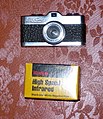Meopta
This article needs additional citations for verification. (June 2015) |
| Formerly | Optikotechna |
|---|---|
| Industry | Optical, opto-mechanical and opto-electronic systems |
| Founded | 1933 |
| Founder | Alois Beneš Alois Mazurek |
| Headquarters | Přerov, Czech Republic Hauppauge, New York |
Area served | Worldwide |
| Products | Consumer, Industrial & Military applications |
| Revenue | 2,519,362,000 Czech koruna (2017) |
| 99,134,000 Czech koruna (2017) | |
| 178,696,000 Czech koruna (2017) | |
| Total assets | 3,017,122,000 Czech koruna (2017) |
Number of employees | 2,364 (2017) |
| Website | [1] |
Meopta optika sro is a Czech Republic based company that manufactures various products mainly in the field of optics. The company was started in 1933 under name Optikotechna in Přerov with the intention of producing a limited range of lenses and condensers, however the production rapidly expanded to include enlargers, composite lenses, binoculars, rifle scopes, cameras and slide projectors. Meopta U.S.A., Inc. is a separate American company that manufactures and assembles optical and optomechanical systems for the Consumer, Industrial and Military Markets.
After 1935, Meopta optika became a subsidiary of Zbrojovka Brno and a major supplier of military optics for the Czechoslovak Army. Company retained its focus on military production when it was seized by Germans during the occupation of Czechoslovakia as well as after WW2, when it was nationalized and renamed as Meopta – an acronym for Mechanická optická výroba - mechanical optical manufacturing. Apart from military deliveries, the company became one of the world's major manufacturers of cinema projectors between 1947 and 1970. The abrupt halt of military demand after the dissolution of Warsaw pact forced the company to refocus mainly on civilian applications.
Today, military production constitutes about 10% of company's production, with 20% of its turnover being generated mainly by optics for sports and hunting applications and 70% being generated by production of optics for cinema and other projectors, optical tools for microprocessors manufacturing quality control, as well as optics for healthcare which are used in various applications such as RTG or mammography.
The company was privatized in 1992. Its majority owners are a Czech family that emigrated to the United States in 1946 amidst the rising power of communists in the Soviet Union liberated and dominated Czechoslovakia. During WW2 the three brothers had been - together with both their parents - active soldiers of the 1st Czechoslovak Army Corps and were decorated for their war duty.
Meopta U.S.A., Inc. is a separate company that was founded by the same Czech-American family in New York in 1960 under the name Tyrolit Company, Inc. At that time, its main business was selling grinding wheels in US and Canada. Tyrolit gradually changed its focus to manufacturing various optical products and in 2005 was renamed to Meopta U.S.A., Inc.[1][2][3]
Cameras
-
Flexaret VII Automat 1967
-
Milona
-
Mikroma 16mm subminiature camera
|
TLR 6x6
[4] Folding 6x6
|
Interchangeable lens (viewfinder/rangefinder) 35mm
Fixed lens 35mm
Stereo 35mm
16mm Subminiature
Large format 13x18
|
Movie Cameras
-
Admira 8F
8 mm Cameras
- OP 8 (1939)
- Sonet 8 (1956)
- Admira 8 D (1946–47)
- Admira 8 IIa (1954)
- Admira 8 F (1960–64)
- Admira EL 8 (1960) - one and only camera having the Zoom lens
- Admira 8 G1 (1966–68)
- Admira 8 G2 (1966)
- Admira 8 G0 (1968–73)
- Admira 8 G1 Supra (1968–71)
- Admira 8 G2 Supra (1968–71)
- Admira 8 L1 Supra (1971)
- Admira 8 L2 Supra (1971)
- Supra is an indication for Super 8.
9.5 mm Cameras
- Admira Ledvinka (Pocket) (1934)
16 mm Cameras
- Admira 16 (1937)
- Admira 16 A1 el. (1963–68)
Movie Projectors
-
Meopton UM 70/35
8 mm and 9.5 mm Projectors [5]
- Scolar (1934)
- Sonet 8 (1938)
- OP 8 (1936)
- Optilux (1945–50)
- Jubilar 9.5 (1945–50)
- Atom (1940–45)
- Meo 8 (1954–60)
- AM 8 (1960–69)
- Meocord (1966–67)
- AM 8 Super (1967–70)
- Meolux I (1969)
- Meolux II (1972–77)
- Meos (1978)
- Meos Duo (1977–86)
- KP 8-2 Super (1976–80)
16 mm Projectors [6]
- OP16 silent and sound (1938)
- OP 16 (1951)
- Opefon (1945)
- Almo 16 (1936)
- Pictureta (1936)
- Meopton I (1945–50)
- Meopton II (1945–50)
- Meopton IIa (1966)
- Club 16 (1962–63)
- Meoclub 16 (1965)
- Meoclub 16 Automatic (1968)
- Meoclub 16 Automatic H (1970)
- Meoclub 16 Standard (1974–78)
- Meoclub 16 Electronic (1980–84)
- Meoclub 16 AS 2 (1982–84)
- Meoclub 16 Electronic 2 (1984)
35 mm Projectors [7]
- Eta 7 (1947)
- Meopton III (1955–57)
- Meopton IV (1959) - IV S with magnetic soundhead
- UM 70/35 (1963–73)
- MEO 5X series (1978-?)
References
- ^ http://olomouc.idnes.cz/druha-svetova-valka-meopta-prerov-paul-rausnitz-f6j-/olomouc-zpravy.aspx?c=A150430_2159628_olomouc-zpravy_stk
- ^ http://www.meopta.cz/cz/historie-1404041196.html
- ^ http://www.denik.cz/ekonomika/generalni-reditel-meopty-biatloniste-nedaji-na-nase-dalekohledy-dopustit-20150602.html
- ^ "Movie cameras | Meopta". Meoptahistory.com. Retrieved 2013-10-16.
- ^ "Projectors 8 and 9.5 mm | Meopta". Meoptahistory.com. Retrieved 2013-10-16.
- ^ "Projectors 16 mm | Meopta". Meoptahistory.com. Retrieved 2013-10-16.
- ^ "Projectors 35 mm | Meopta". Meoptahistory.com. Retrieved 2013-10-16.





